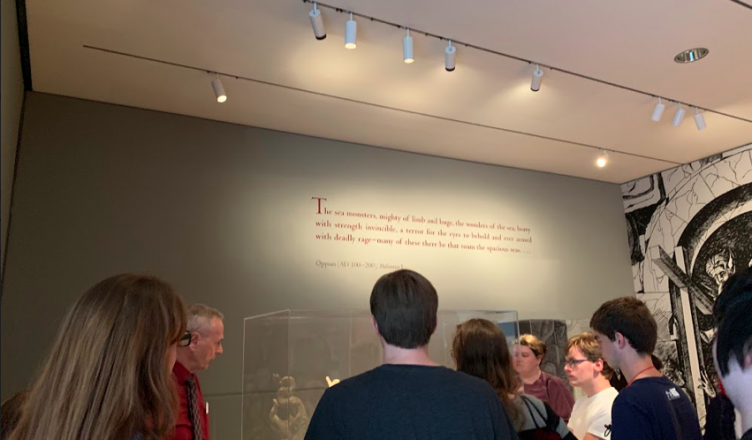Monsters: how do we see them in a historical sense? Often times when asked this question, people look to the Middle Ages, perhaps because of popular role-playing games based on the era, others because of the air of superstition that shrouds that period of time. Whatever the case, The Cleveland Museum of Art displayed an exhibit of exquisite art depicting the true thoughts and beliefs of medieval artists on “medieval monsters.”
Beginning in July of 2019 and running through early October, The Cleveland Museum of Art played is playing host to an astounding collection of medieval artifacts depicting monstrous creatures, the first of its kind in North America, entitled “Medieval Monsters: Terrors, Aliens, Wonders.” I was fortunate to be able to attend this exhibit on September 24, 2019, on a field trip with OWU’s Ancient, Medieval, and Renaissance Studies Program (AMRS). I was therefore able to put the teachings of the AMRS classes I have taken into perspective.

I walked into the museum expecting the exhibit to show an abundance of literal monsters. Don’t get me wrong, there were a number of them; however, the art work displayed leaned more toward the metaphorical. There was an amplitude of Christian themes, often portraying the ‘monstrous’ quality of sin and even the effects of plague. But there were some surprises too. Dr. Patricia DeMarco said it best:
A few of us noted a modern secular slant: many of the curator’s chosen illustrations of monstrosity involved medieval religious images and themes. It was provocative to be asked to think about medieval female saints as monsters — a very different point of view on the superhuman/supernatural/divine!
There was a graphic representation of hell, shown as the creature “Hellmouth.” This creature was a motif we saw multiple times throughout the exhibit, represented as a large beast that would literally swallow you, thus sending you to hell. People were drawn within its gaping maw, weeping over their fate. Along with Hellmouth, we were shown various depictions of the divine intervention of God, Jesus, Mary, and angels and saints rescuing sinners from monstrous foes. Some pieces seemed to represent forgiveness and protection whereas others represented repentance and dismay.
Accompanying the religious themes, there were also depictions of marginalized groups, also represented as monstrous. Medieval artists would often render these peoples in their paintings with characteristic attire. While at first glance one may have looked at the art and have simply seen renderings of communities of the time, a trained eye would be able to understand that the commonalities that various people shared, via hats or headgear, impressiveness of dress, etc. all separated people into categories of “other.”
There was brief depictions of female-oriented monsters, which was what I was personally most excited about. These instances included Sphinxes and Sirens. While they were not displayed to the extent of the Hellmouth (or even demons), they were still gorgeous in their artistry and impactful in their symbolism. From the explanations given by our tour guide and plaques, alongside what I’ve learned in the various classes OWU offers, I gathered the common ideal of blaming women for attempting to live outside of the confines of the patriarchy. Hence, this is why some of the most dastardly creatures in history were female monsters.

Perhaps my favorite part of the exhibit was the awe-inspiring unicorn horn! Before you say, “But unicorns aren’t real, you buffoon,” allow me to explain. We were shown a rather large tusk of a narwhal. Why? Many sailors of the time were reported to have collected these tusks on their voyages and upon their return would present them as magical artifacts! This ploy tricked many families of notable wealth, who would purchase the tusks and display them in curio cabinets as the unicorn horns they had been assured they were. The tour guide highlighted this as it was one of the first instances of museum exhibit practice!
Overall, the “Medieval Monsters: Terrors, Aliens, Wonders” exhibit hosted by the Cleveland Museum of Art was a combination of various elements that made you question your definition of what is monstrous. As a whole, the group who accompanied Dr. DeMarco all loved the trip, each walking away with a better understanding of the creatures and history that we know and love. “I loved getting to see so many works of medieval art in one place,” said Drake Ogden. “I also got to see their permanent medieval exhibit after the tour, and it was amazing to be able to see metalworking and sculpture from over 1000 years ago!”student Another student, Capri Pappas, noted:
It was very exciting for me to see more books of hours in person. I attended a talk the day before this trip at Ohio State University with Dr. Carol Neuman de Vegvar titled, ‘Books of Hours as Transformative Works’ by Dot Porter. Books of hours were very personal and treasured objects–the sheer range of sizes that we saw at the Cleveland Museum was a good example of how portable they could be, and the fact that monsters were included in these books shows how often the medieval person’s mind pondered their existence!
While the exhibit wasn’t exactly what I had pictured, as a group we walked away with a better understanding of medieval times, and how the monsters depicted in their art were used to symbolize the common beliefs rather than simply superstitious legend. Here’s looking forward to another wonderful opportunity to travel with the AMRS Program!





